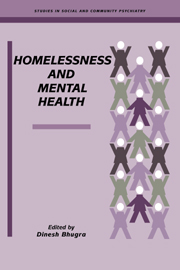Book contents
- Frontmatter
- Contents
- List of contributors
- Preface
- Part I INTRODCTION AND SPECIAL GROUPS
- Part II SERVICES
- Part III INTERNATIONAL PERSPECTIVE
- 12 European perspectives
- 13 Lessons from America: semantics and services for mentally ill homeless individuals
- 14 Homelessness and mental health: lessons from Australia
- Part IV POLICY AND EVALUATION
- Index
14 - Homelessness and mental health: lessons from Australia
from Part III - INTERNATIONAL PERSPECTIVE
Published online by Cambridge University Press: 15 October 2009
- Frontmatter
- Contents
- List of contributors
- Preface
- Part I INTRODCTION AND SPECIAL GROUPS
- Part II SERVICES
- Part III INTERNATIONAL PERSPECTIVE
- 12 European perspectives
- 13 Lessons from America: semantics and services for mentally ill homeless individuals
- 14 Homelessness and mental health: lessons from Australia
- Part IV POLICY AND EVALUATION
- Index
Summary
Introduction
The extent of serious mental illness among single homeless people, broadly defined, is similar in Australia to that found elsewhere in the Western world (Scott, 1993). During the 1980s in Australia the problems of ill and disaffiliated people became increasingly apparent to service agencies. The problems have been less visible than in other parts of the world, hidden to a large degree in special accommodation houses, cheap boarding houses and shelters or crisis accommodation centres (Doutney et al, 1985; Herrman et al., 1989; Teesson & Buhrich, 1990, 1993; Virgona et al., 1993). Even so, national reports estimate that thousands of Australians, and in particular many thousands of young people, live without adequate shelter (HREOC, 1989; Neil et al., 1992).
A relatively high proportion of homeless people have a mental illness, but many do not. The problem of homelessness, for those with or without severe mental illness, is influenced by the social and housing issues that affect all marginalized people. At the same time it is important to recognize among the homeless those who would benefit from psychiatric treatment, and the barriers to care that exist (Bachrach, 1987). Furthermore, homelessness among mentally ill people may be seen in part as a reflection on inadequacies in the delivery of health, welfare and housing services to those with severe mental disorder, many of whom develop multiple disabilities and handicaps, and to their families and other caregivers.
Homelessness was defined recently in an Australian government report as: ‘that state in which people have no access to safe and secure shelter of a standard that does not damage their health, threaten their personal safety, or contribute to their marginalisation by the absence either of cooking facilities or facilities that permit adequate personal hygiene’.
- Type
- Chapter
- Information
- Homelessness and Mental Health , pp. 244 - 264Publisher: Cambridge University PressPrint publication year: 1996
- 2
- Cited by



